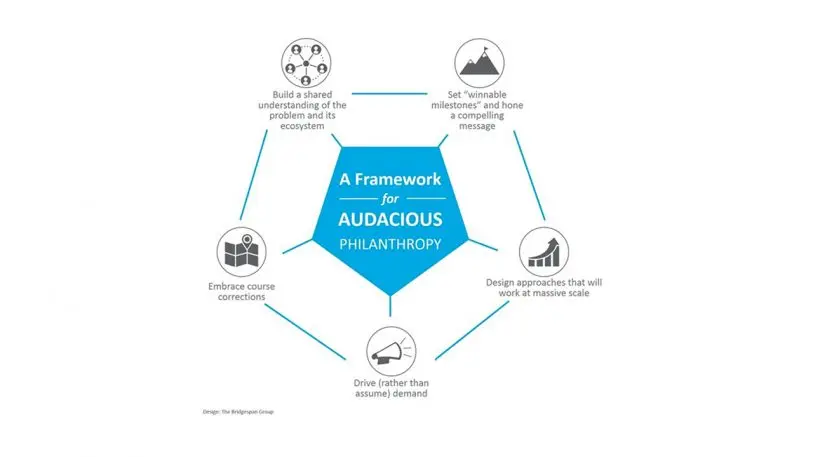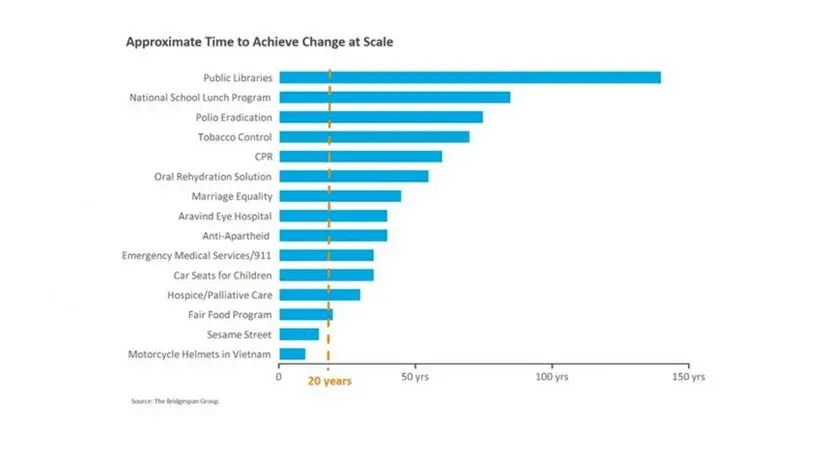About 80% of the world’s richest philanthropic claim to want to invest in social change, but only 20% do. That well-documented fact dubbed the “aspiration gap” stems from the fact that tackling complex societal issues is far trickier than, say, just donating huge sums to your alma mater or building a new museum wing.
Big complex investments also take time to pay off. In fact, an analysis of 15 major societal changes–from the advent and widespread adoption of CPR to establishing marriage equality–shows that 90% of those efforts took over 20 years of continuous effort to develop, according to Bridgespan, a nonprofit consultancy.
They were also complex: 80% of those ventures required changes to government funding or policies along the way, while 75% involved coordination across numerous industries. And price? The majority also cost $10 million or more. To incentivize major philanthropic funders to keep at it, Bridgespan researchers have developed a “framework for audacious philanthropy,” which was just published in Harvard Business Review.

According to the HBR report, mega-charitable efforts that succeed tend to do 5 main things: Build a shared understanding of the problem and its ecosystem; Create emotionally compelling winnable milestones; Design for massive scale; Drive (don’t assume) demand; Embrace course correction. Any group chasing the next big social good gain should be thinking about these elements as a necessary checklist; the best movements have included all of them, ensuring their massive amount of time and money was being well spent. Bridgespan offers a trove of additional research here.
Build A Shared Understanding Of The Problem And Its Ecosystem
Take the fight to cut the smoking rate: Over at least five decades, the American Cancer Society allied with the Robert Wood Johnson Foundation to first study how exactly tobacco use was harmful, and then make the habit less appealing by regulating advertising, upping taxes, and limiting where people could smoke and where cigarettes were bought and sold. As a result, smoking rates have dropped from 42% to around 15% today.
Create Emotionally Compelling Winnable Milestones
The battle for marriage equality, in particular, is a good demonstration of how messaging matters: LGBT equality groups used polls and focus groups to figure out their core mantra “love is love”–it worked better than advocating for equal tax breaks–and began a state-by-state battle to shift public perception with each place a milestone toward federal inclusion.

Design For Massive Scale
CPR is so popular today because the American Red Cross and American Heart Association have figured out an easy way to teach it to lifeguards and high schoolers alike. The method only spread, though because doctors worked hard to figure out a shorthand process for restarting a heart, which once required open chest surgery.
Drive (Don’t Assume) Demand
Sesame Street took off in the late 1960s because The Carnegie Corporation realized that in order to get folks to tune in, it needed to drive demand from the outset, and so spent heavily on both production and advertising values (not to mention measuring its impact and reach, to share important early education milestones).
Embrace Course Correction
The Depression shaped the National School Lunch program, which was initially considered a huge success until researchers discovered that local assessments were off, leaving many kids still hungry. This prompted the creation of federal guidelines, an influx of funding, and better targeting to find those most at-risk–a great example of course correcting.
“For the types of social challenges targeted by audacious philanthropists and other change makers, adaptation informed by robust measurement is key,” add co-authors Susan Wolf Ditkoff and Abe Grindle in the HBR article. “To fuel progress, funders need to make sure that both their attitudes and their funding reflect that reality.”
Recognize your brand’s excellence by applying to this year’s Brands That Matter Awards before the early-rate deadline, May 3.
